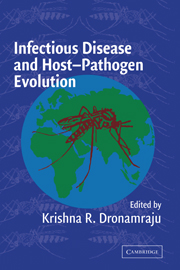Book contents
- Frontmatter
- Contents
- List of Contributors
- Introduction
- PART ONE J. B. S. HALDANE
- PART TWO MALARIAL PARASITES
- 3 Evolutionary Genetics of Plasmodium falciparum, the Agent of Malignant Malaria
- 4 Evolutionary Biology of Malarial Parasites
- 5 G6PD Deficiency and Malarial Resistance in Humans: Insights from Evolutionary Genetic Analyses
- 6 The Enigma of Plasmodium vivax Malaria and Erythrocyte Duffy Negativity
- PART THREE OTHER PARASITES
- PART FOUR GENETIC AND EVOLUTIONARY CONSIDERATIONS
- Index
- Plate Section
- References
3 - Evolutionary Genetics of Plasmodium falciparum, the Agent of Malignant Malaria
Published online by Cambridge University Press: 10 August 2009
- Frontmatter
- Contents
- List of Contributors
- Introduction
- PART ONE J. B. S. HALDANE
- PART TWO MALARIAL PARASITES
- 3 Evolutionary Genetics of Plasmodium falciparum, the Agent of Malignant Malaria
- 4 Evolutionary Biology of Malarial Parasites
- 5 G6PD Deficiency and Malarial Resistance in Humans: Insights from Evolutionary Genetic Analyses
- 6 The Enigma of Plasmodium vivax Malaria and Erythrocyte Duffy Negativity
- PART THREE OTHER PARASITES
- PART FOUR GENETIC AND EVOLUTIONARY CONSIDERATIONS
- Index
- Plate Section
- References
Summary
We have investigated the population structure of P. falciparum by analyzing several genes and conclude that the extant world populations of this parasite have evolved from a single strain within the past several thousand years. The evidence is based on a lack of synonymous polymorphisms among nuclear antigenic and nonantigenic genes; among introns; and among mitochondrial loci. Coalescence calculations for silent nucleotide variation converge in each case into a single ancestral allele. The extensive polymorphisms observed in the highly repetitive central region of the Csp gene, as well as the apparently very divergent two classes of alleles at the Msp-1 gene, are consistent with this conclusion.
Understanding the population structure and evolution of Plasmodium has important implications for the control of human malaria.
The human toll of malaria is stunning, perhaps the greatest of all human afflictions (Sherman, 1998). Malaria is caused by species of Plasmodium, a parasitic protozoan. Four species of Plasmodium are parasitic to humans: P. falciparum, P. malariae, P. ovale, and P. vivax. P. falciparum is the most pervasive and malignant human malarial parasite. It causes yearly 300 million to 500 million cases of clinical illness and 1.5 million to 2.7 million deaths in sub-Saharan Africa, plus 5–20 million clinical cases and 100,000 deaths elsewhere in the world, 80% of them in Asia (Trigg and Kondrachine, 1998).
The genus Plasmodium consists of nearly 200 named species that parasitize reptiles, birds, and mammals.
- Type
- Chapter
- Information
- Infectious Disease and Host-Pathogen Evolution , pp. 39 - 74Publisher: Cambridge University PressPrint publication year: 2004
References
- 3
- Cited by

